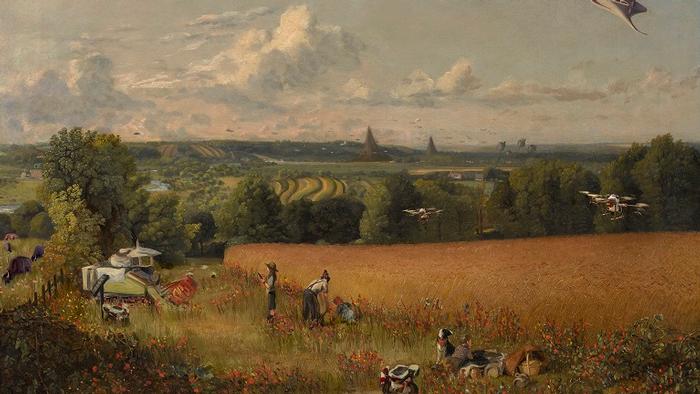Expertise of Engineering lecturer drawn upon to re-imagine classic paintings for climate change exhibition
"Helping to develop artwork like this was about sending a message to both policymakers and the public regarding the vital contribution the UK’s agricultural engineering sector can make to our Net Zero goals during COP26. I also hope it will capture the imaginations of prospective students and inspire our current Agricultural Engineering students here at Harper Adams University.”
The expertise of a Harper Adams University lecturer has been drawn upon to help re-imagine classic paintings for a new exhibition examining how engineering can help tackle climate change.
The This is Engineering - Engineer the Future exhibition, by the Royal Academy of Engineering, looks at some classic works by painters such as Constable, Monet, Pissarro, and Van Gogh – who all made their mark during the first industrial revolution – and re-imagines them for the 21st century.
With the eyes of the world on Glasgow as delegates gather for the COP26 Summit, the exhibition, which is being run both online and physically as an exhibition in the city, aims to examine how engineering advances can help to achieve net zero carbon emissions by 2050.
Engineer the Future sees Van Gogh’s Factories at Clichy, Constable’s The Wheat Field, Pissarro’s La Rue Saint- Honoré and Monet’s The Seashore at Sainte-Adresse digitally remastered by contemporary artist, Ashly Lovett, to show how engineering innovations could help to transform everyday life and landscapes in the future.
Kit Franklin, Senior Lecturer in Agricultural Engineering at Harper Adams University and Principal Investigator on the Hands Free Farm project, said: “It is always an honour to work with the Royal Academy of Engineering on a project and I was delighted to be asked to assist with this thought-provoking campaign.
“Helping to develop artwork like this was about sending a message to both policymakers and the public regarding the vital contribution the UK’s agricultural engineering sector can make to our Net Zero goals during COP26. I also hope it will capture the imaginations of prospective students and inspire our current Agricultural Engineering students here at Harper Adams University.”
Meanwhile, environmentally friendly hydrogen planes can be seen in the sky, with futuristic shapes that maximise fuel-efficiency and range of travel.
Kit says: “The artistic reinterpretation of Constable has removed the hard physical labour and repetitive tasks of agricultural farmhands as autonomous robots take on the work humans would have traditionally done.
“Agbots make farming more precise to conserve vital resources like water and energy and we’ll see smaller machines in future to help preserve soil quality and health. A healthy soil is not only vital for growing food, it can also sequester carbon more effectively than one that has been compacted by large machinery.
“If Constable were to walk in the British countryside in 2050, he’d see smaller fields with strips of different coloured crops, and less productive fields rewilded with trees, wildflowers and shrubs to boost biodiversity and pollination.”
As well as seeking to raise awareness of the ways in which engineering can help meet Net Zero targets, the This is Engineering campaign also seeks to promote engineering careers to tackle a significant skills and diversity shortfall in the profession.
Dr Rhys Morgan, Director of Engineering and Education at the Royal Academy of Engineering, added: “The UK’s goal of reaching net zero carbon emissions by 2050 is a massive undertaking. Decarbonisation on this timescale and magnitude will bring widespread and rapid change to every aspect of daily life and meeting our goal of a net zero future will not be achieved without engineering expertise.
“From the ways we heat, cool and light our homes, to how we produce our food, how we build our houses and how we travel around, our future daily lives will be shaped by today’s engineers and engineering.
“These famous masterpieces originally captured a snapshot of daily life at a time when the consequences of carbon emissions were not known. By reimagining them for 2050 we hope to start a conversation about how engineers can help shape our net zero future and inspire the next generation to join the profession. To realise the emission-saving technologies imagined in these artworks, the UK needs more engineers – for example, National Grid estimates that the UK energy sector alone will need to fill 400,000 roles between now and 2050 to reach net zero.”
In a bid to boost recruitment and challenge the narrow stereotypes of what engineers look like and do, This is Engineering Day – being held this year on Wednesday, November 3 - is an annual reminder of the importance of engineering to our daily lives.
Created by the Royal Academy of Engineering in 2018, the day celebrates the varied and vital roles that engineers play, from developing medical technologies like brain scanners and clean energy solutions, to powering the social media platforms and smartphones we rely on to keep in touch every day.




